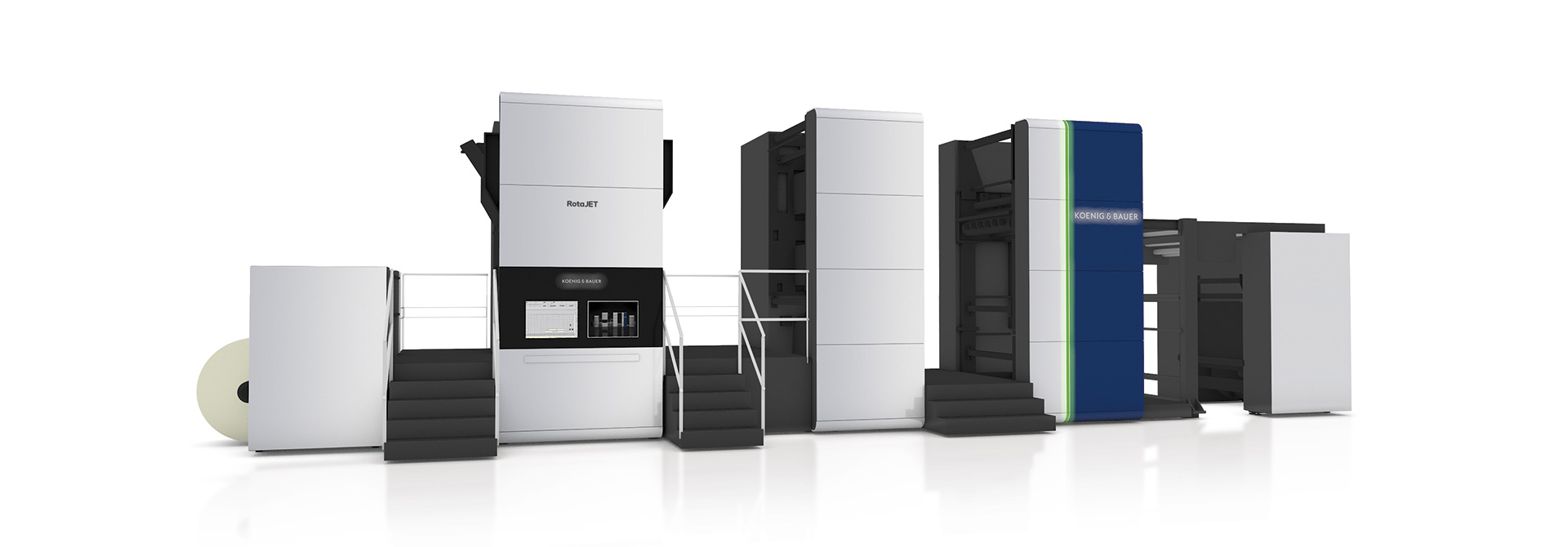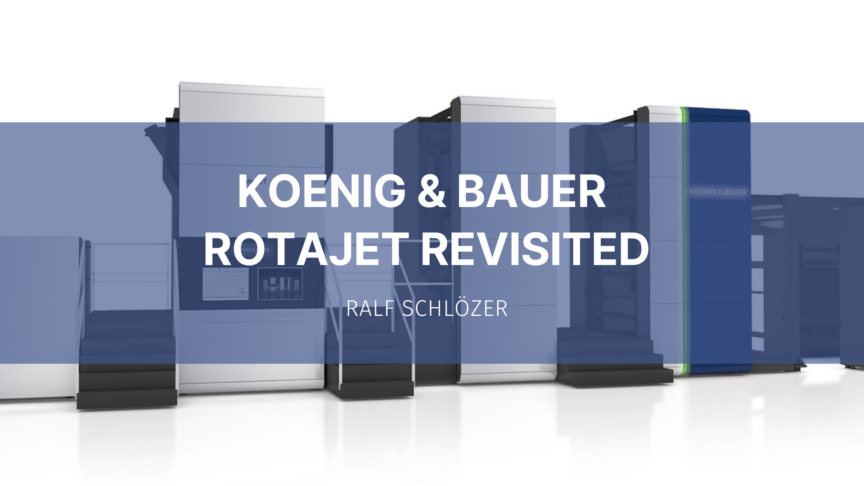With more than 200 years of company history, Koenig & Bauer is the oldest printing press manufacturer. At the same time, Koenig & Bauer is an innovative company with activities in a wide range of markets, not lest inkjet. Earlier this year we covered the various offerings using inkjet technology.
Besides its own branded presses, Koenig & Bauer is the manufacturing partner of HP for the press base of the T1100 series of preprint corrugated presses. The flagship product in continuous feed inkjet is the RotaJET, however.
The first RotaJET was first showcased back at drupa 2012. The version on display was a RotaJET 76 for commercial print with a web width 781 mm (31”), which would allow for 3-up production of A4 pages. This was quickly followed by the announcement of the RotaJET L platform in 2014 going much wider. It was not a surprise that there were some teething problems for a traditional press manufacturer launching its first high-volume inkjet press. Press design, inks, head control and workflow had some revision cycles to come to the well-rounded press available today. It became apparent as well, that a solidly designed press from Koenig & Bauer, with its heritage in high-performance web offset presses, had a tough time competing head-on against mainstream presses from established continuous feed inkjet press manufacturers. This meant honing in on the strengths the RotaJET offered and focussing on selected applications.
The RotaJET line-up
Today, there are two closely related product lines available. The RotaJET L Commercial focusses on commercial and publishing markets. Web widths of 77 to 138 cm (30” to 54”) are available, although if required wider widths are available. The press has a two-tower design for duplex print. The web speed is up to 270 m/min with up to 1,200 dpi resolution. Polymer inks developed by Koenig & Bauer are available for strong colours on coated and uncoated papers. The press can use Koenig & Bauer’s automated reel changer and paper logistics systems.
The Industrial line includes the RotaJET L and RotaJET VL as simplex web presses. The VL covers the web widths from 130 to 225 cm (51” to 88”) at speeds up to 135 m/min. The inks for the industrial presses can vary as do the applications. Again, reel changer and paper logistics systems are available. If required Koenig & Bauer is able to modify substrate transport and drying.
The RotaJET is very modular and configurable, hence it could address a large range of markets. Koenig & Bauer however identified four applications as the most promising today.

Book printing
There is a large range of continuous feed inkjet presses out there, that are used for book printing. However, there are areas where the RotaJET is unique: print width. Although initially a few smaller width RotaJETs were installed in book printing, the focus is now on the 130 cm (51”) and 168 cm (66”) widths. This format matches older analogue Timson presses, once very popular in book printing. The wide width allows using the same reels of paper and the same formats for finishing, making a mixed workflow quite seamless. Installations are at Grafica Veneta in Italy and Lake Book Manufacturing in the US.
Obviously, not all book printers have the volumes to keep such a press busy. Neither do all book-on-demand print sites have a legacy in analogue print. For some sites, however, the RotaJET can be the right tool to move from analogue to digital print.
Décor printing
A segment the RotaJET had success early on is wood décor printing. Again, the width is a major factor, and the presses installed in this segment are 168 or 225 cm wide. Digital print in décor not only allows for short runs and a fast time to market, but crucially the cut-off is flexible as well to allow for unique decors. Koenig & Bauer offers a set of RotaColor decor inks adapted for this market for a good match to other prints and high lightfastness.
German décor printer Interprint invested early on and has three lines running now. Other users are Swiss Krono and Mimmetic. All sites are in Europa but Koenig & Bauer expects to address other regions soon.
Aseptic cartons
A somewhat specialised area in packaging are aseptic or liquid cartons.
In 2019 the announcement of Tetra Pak to invest in a RotaJET 168 made some waves. The pandemic put a spanner in getting the press up and running quickly but finally the press is in operation at a site in Texas. After extensive testing, Tetra Pak now offers low volumes of bespoke aseptic cartons for drink companies or the inclusion of dynamic QR codes. What constitutes low volumes is in the eye of the beholder, however, as a project for customised water packs consisted of more than 100 million packages. Accordingly, the high productivity of a RotaJET is well needed. Tetra Pak plans to further expand this market and is still evaluating the opportunities and best customer approaches. The market can be potentially large with Tetra Pak having 52 production plants around the globe.
There are not many other players in large-scale aseptic carton printing besides Tetra Pak, although some exist. In 2023 SIG in Germany invested in a RotaJET 168 as well, to offer aseptic cartons for the European market.
Packaging
Besides aseptic cartons other packaging markets exist that are potentially targeted with the RotaJET. It is still early stages as the various markets have specific requirements and require extensive testing. Not all is public. For example, in 2020 Koenig & Bauer announced a cooperation with a new partner in printing on flexible films with waterbased inks. Initially, first results were announced for 2022, although concrete projects or installations have not been made public yet.
Somewhat mysterious is the cooperation announced with Sealed Air (SEE) in 2023 for the RotaJET. SEE is a developer of packaging solutions with over 16,000 employees and 97 manufacturing facilities. Koenig & Bauer has a partnership on analogue presses already. It was stated that: “The partnership aims to significantly improve packaging design capabilities by developing state-of-the art digital printing technology, equipment, and services. Solutions developed by SEE and Koenig & Bauer will scale and deliver digitally printed materials dramatically faster, enabling brand owners to promote products by connecting with consumers through a digitally enhanced package.” The RotaJET will feature SEE’s prismiq intellectual property, software and hardware, although details have not been made public.
Publicised is that Koenig & Bauer is cooperating with Sappi and UPM on heat-sealable and barrier papers. Given all the activities we can expect more announcements on the RotaJET in packaging in the future.
Growing the base
After a slow start, the RotaJET did gain traction in recent years. The press does well, where other inkjet solutions fall short in productivity, width, and handling of delicate substrates. As a solid, well-engineered press the RotaJET-Series caters to high-volume users. Unfortunately, this also can be a hurdle when moving into a digital print business model for the first time, in having sufficient volume at the start. It also requires rigorous testing to make sure the high volumes can be produced consistently – which does prolong installation and testing cycles noticeably. Accordingly, it is encouraging that RotaJET placements did pick up noticeably in recent years and I expect to hear more interesting announcements soon.

